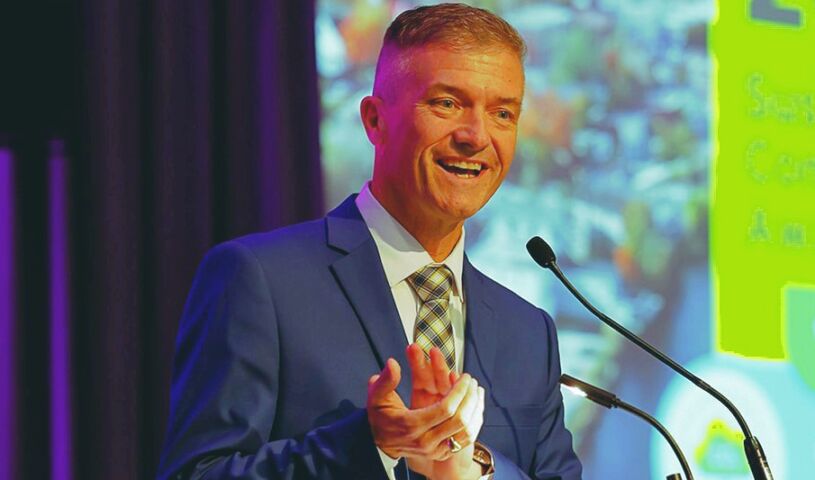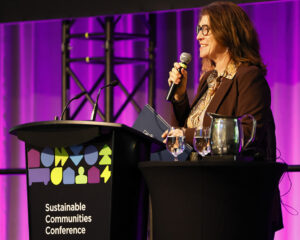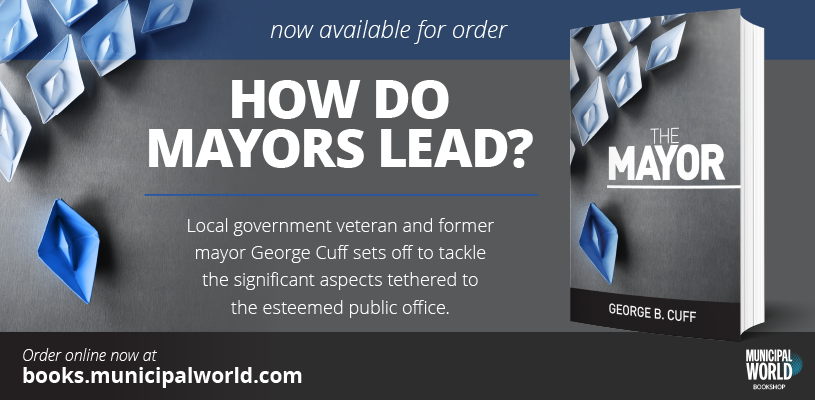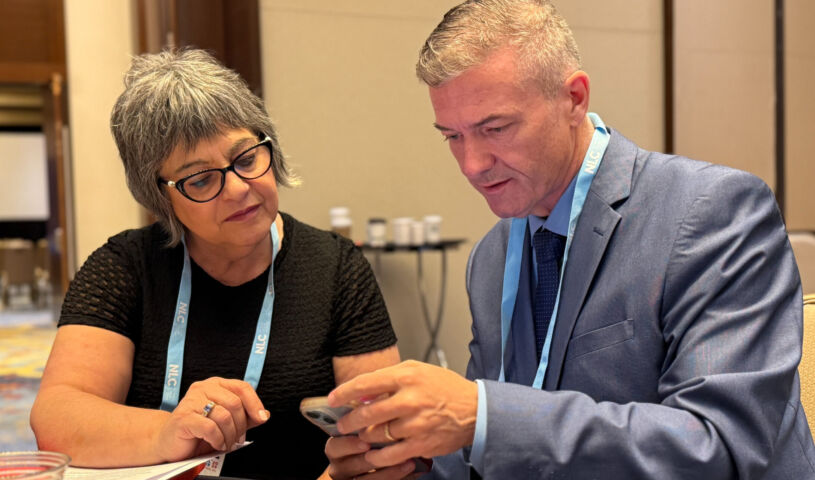FCM leads the charge for sustainable communities
 Tim Tierney, FCM’s first vice president and City of Ottawa councillor, was one of the speakers at the 2025 Sustainable Communities Conference. Photo: Tim Tierney
Tim Tierney, FCM’s first vice president and City of Ottawa councillor, was one of the speakers at the 2025 Sustainable Communities Conference. Photo: Tim Tierney
The creation of more sustainable communities is firmly on the minds of municipal leaders.
First, the Federation of Canadian Municipalities (FCM) once again brought together municipal sustainability practitioners and local leaders from across the country at the 2025 Sustainable Communities Conference (SCC). Held Feb. 10-13 in Fredericton, N.B., the SCC is designed to help delegates learn from each other and share actionable solutions toward a more resilient and sustainable future.
Then, on the final day of the conference, Steven Guilbeault (who at the time as Minister of Environment and Climate Change) helped announced Ottawa would spend $30 million to support more resilient communities. The Green Municipal Fund’s Local Leadership for Climate Adaptation initiative is funding 30 projects, 17 feasibility studies, and 34 partner grants to address climate adaptation.
“Climate change is causing more frequent extreme weather events across the country, and municipalities have been at the forefront of helping their residents stay safe and recover,” Guilbeault said. “Today’s investments are a crucial step in supporting local initiatives that will help build safer and more resilient communities for generations to come.”
Building a Sustainable Future
Tim Tierney knows a thing or two about why it is so critical that municipalities focus their efforts on sustainability. Tierney, FCM’s first vice president, is also a City of Ottawa councillor and member of the municipality’s Environment and Climate Change Committee.
Reflecting on the SCC, Tierney said the first thing to take note of was the conference’s enrollment. A sold-out crowd of 538 delegates took part in the SCC. These sustainability conversations, Tierney said, are more important than ever given how municipalities are now dealing with climate events they have never dealt with before.
Tierney emphasized the increasing frequency of extreme weather events, including one-in-100-year storms, shoreline erosion, tornadoes, and wildfires. These events are having a profound impact on municipal infrastructure and communities.
“We’re going to see more of this in the future as you see more climate impact on municipalities where we’re burdened with the cost,” Tierney said. “These are identifiable issues that really impact the municipalities, and we need [the federal government] to help. I’m very proud of what happened at the conference.”
Shared Municipal Conversations

Fredericton Mayor Kate Rogers, who served as host for the Sustainable Communities Conference, said it was inspiring to see more than 500 municipal leaders come together around sustainability. Photo: Kate Rogers
The funding Guilbeault announced, alongside FCM President Rebecca Bligh and others, will help municipalities address urgent climate risks. The goal is to protect infrastructure, enhance public safety, and reduce long-term costs.
Funded GMF partners will provide communities with tailored training, tools, and resources to build the knowledge and technical capacity needed to put in place effective climate adaptation strategies.
This support is essential for municipalities to deal with the sustainability issues. It’s a reality Fredericton Mayor Kate Rogers understands.
Rogers said it was inspiring to see more than 500 municipal leaders come together around sustainability. One of the many benefits of FCM, Rogers said, is that it brings municipal leaders from across the country together to talk about their shared experiences.
For example, one thing that municipalities have in common is emergency measures and how they respond, regardless of the crisis. Rogers said that while the individual emergency might differ, the response is often similar – not the measures that are put in place, but how the response is delivered.
“There’s lots of commonality. Our city had three one-in-100-year floods. We had three of them in a decade. We’re not alone in having to deliver that kind of response,” Rogers said. “We are seeing that with the forest fires that are happening year over year in certain parts of the country. So just to have those conversations with other leaders is very helpful. And some of us have figured out certain parts better than others, and we just share that knowledge.”
Importance of Resiliency
The conversation around sustainability is often focused on the environment and climate change. But this doesn’t include the full picture of the issues municipalities face in building sustainable communities.
For his part, Tierney said he sees the conversation around sustainability focused more on what he calls resiliency. Resiliency is a “big factor,” Tierney said. For example, when power goes out in a neighbourhood, what can the municipality do to assist with those kinds of things or the damage and destruction that come after a significant climate-related event?
More than ever, Tierney said, the public is understanding how important the conversations around sustainability are.
There was a time, he added, where the public thought about climate change as simply a problem related to the weather. But, today, people realize it is about multiple weather patterns that have changed. Critical conversations around flooding, cold extremes, or excessive snow are all examples Tierney pointed to as Ottawa having to deal with in recent years.
“Since 2008, we haven’t had a dump of snow like this in Ottawa. Guess what? We’re left now with massive problems where we have snowbanks that are extremely high. So what can we do about it?” Tierney said. “People are now waking up. We don’t care if you call it climate, or resiliency, or whatever, we understand there’s a problem and municipalities need that money to resolve that issue.”
Shift Toward Sustainability
Municipalities can’t take on the sustainability challenge alone, Rogers said. But she also understands that issues ranging from climate change to the local infrastructure deficits are no longer viewed as minor.
Rogers has been in municipal government since 2012. Since that time, she said, the conversations around sustainability have evolved a lot. For example, there was a time Fredericton didn’t have an environmental stewardship standing committee. It was simply an occasional conversation as part of public safety.
Now, the city has standing committee meetings monthly to discuss climate mitigation and resiliency. That, she said, is “a huge shift” over the past 13 years.
One thing that shift also includes is what Rogers calls the connection between sustainability and affordability.
“We’re trying to put it in place because they really do go hand in hand. It’s very expensive for individual households to deal with a crisis.” Rogers said. “We’re also very focused right now on delivering an affordable city to our residents as they face so many economic challenges. And so I think that for me, our environmental and sustainability work also helps with that.”
Importance of Partnership
The support coming from Ottawa will undoubtedly help initiatives like the GMF support municipalities. But at the same time, $30 million represents a fraction of what municipalities need to address their sustainability issues.
Still, Tierney was quick to thank the federal government for its support through the Local Leadership for Climate Adaptation initiative. Especially, he added, in these times of turmoil in politics in general.
Ontario is coming out of a provincial election, and there is little doubt (Tierney called it the worse kept secret in the country) a federal election is likely just around the corner. Even so, he said it is great to see Ottawa making a commitment going forward right now.
And that, he said, could only become more of a focus once a federal election is inevitably called.
When talking about $30 million, Tierney said, nobody sees that total as “chump change.” But even if it represents a relatively small investment in the problem of sustainability, Tierney said he sees the federal government step up as a game changer for Canadian municipalities.
“Having that direct payment is always great. But at the same time, if they’re talking from an election lens, we need a real focus on what kind of money they’re going to provide,” Tierney said. “If they have to go through the provinces, there better be a good chunk of change for infrastructure. That is going to be one of the biggest struggles municipalities will have over the next foreseeable future with the infrastructure aging out.” MW
✯ Municipal World Executive and Essentials Plus Members: You might also be interested in Ewa Jackson’s article: Empowering communities to build climate-ready infrastructure.
Sean Meyer is digital content editor for Municipal World.
Related resource materials:
- FCM launches fresh approach to funding municipal sustainability
- Municipalities switch to electric buses to cut emissions
- Five sustainable procurement trends to drive sustainability



